Pool tiles: types, selection and installation rules
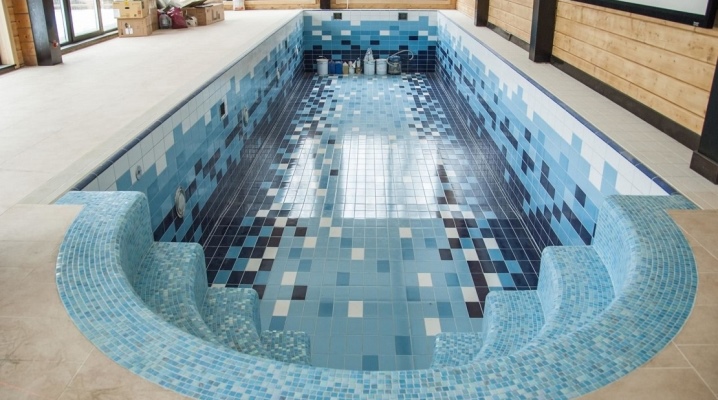
When arranging a pool in a private house, its high-quality lining is important. There are several coating options, of which tile is the most popular material.
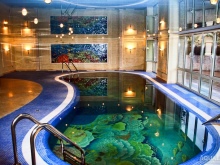

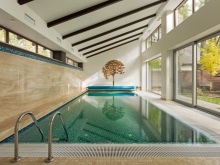
Pool cover requirements
The availability of a large assortment of tiles on sale allows you to make the pool cover colorful and bright. However, ordinary tiles, which are used at home, cannot be used as a covering for a street pond. Tiles designed for outdoor pool cladding must meet certain requirements.
- Have maximum stability to negative natural factors (temperature extremes, frost, bright sunlight).
- To be distinguished by durability, reliability and strength, since a large volume of water will exert strong pressure on the tile. It should also have high impact resistance.
- The indicator of water absorption is also important. Since the tile performs the function of waterproofing, the water absorption coefficient should be very low (no more than 6%). Otherwise, it is able to absorb a lot of water in a short time, which will lead to its internal damage, deformation, cracks and leakage.
- Be resistant to chemicals. Disinfection and cleaning of the pool is carried out using detergents and chemicals, often containing chlorine. These substances react with the surface of the tile, which leads to a gradual loss of the original decorative appearance.
- The tile must meet safety requirements: be non-slip, with embossed and rough surfaces.
- Its surface should not be porous, otherwise, it will not only absorb water, but also become a source of microorganisms, bacteria and mold, which will lead to the formation of mucus and the risk of injury on slippery surfaces.
The decorativeness and aesthetic appearance of the lining of the reservoir are also important.

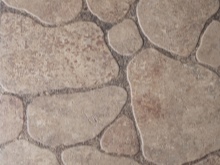
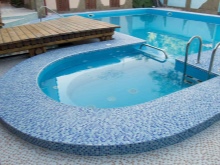
Types of tiles and their characteristics
Several types of tiles are used to cover the pool bowl.
Glass
Glass tiles provide complete sealing, since the water absorption coefficient of glass is practically equal to 0. Its important quality is high frost and heat resistance. It can easily withstand temperatures in the range of -30 - +145 degrees and easily tolerates about 100 changes of freezing and warming.
Exposure to most acids in cleaning chemicals does not harm the glass coating, and the tiles do not change their original color or lose their original attractive appearance.
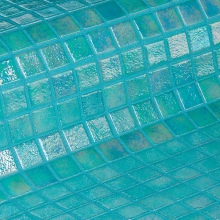


Glass tiles are usually square in shape and vary in size. Small-sized tiles are more convenient to use for facing uneven areas, rounded surfaces and bends. If any cladding element is damaged, it can be easily replaced with a new one.
Floor glass tiles, withstanding high water pressure, do not collapse or deform, due to which they have a long service life. This frost-resistant tile is also distinguished by its high impact resistance, acquired through additional firing during production.
The tile has a very colorful look, and its color palette is very diverse due to the addition of such elements as boron and selenium, cadmium and mother-of-pearl.
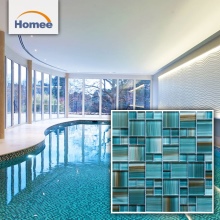
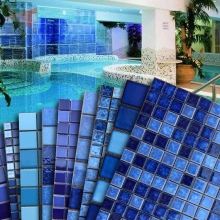
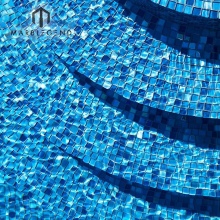
Ceramic
The tile is quite popular and is often used to cover the bowl of the reservoir. Its quality is constantly improving due to the introduction of new additives that increase the positive characteristics of the product (strength, hardness). For its manufacture, such technologies are used that reduce the porosity of the texture of the material while increasing its density.
Ceramic tiles have:
- reliability, long service life, practicality;
- good water-repellent characteristics;
- excellent strength and fire resistance;
- harmlessness to humans and hygienic qualities.
This tile does not require complex maintenance.
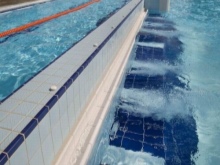
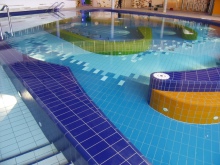
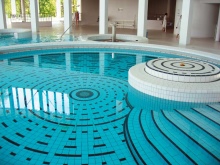
Porcelain is another type of tile. In its production, components such as white clay and feldspar, kaolin and quartz are used. The added oxides of various metals give it a certain color. Its firing takes place at a temperature of +1300 degrees. As a result, all the constituent elements melt, sintering together, which gives the material the highest strength.
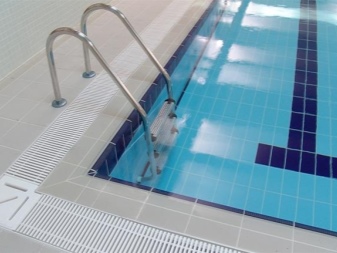
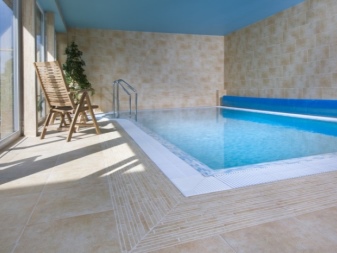
Rubber
Anti-slip rubber tiles are made using unique technologies from high quality raw materials. Having high elasticity and density, it does not crumble or crack, withstands heavy loads and is resistant to mechanical influences.
Possesses the following qualities:
- moisture resistance, since it does not absorb water at all;
- high anti-slip effect - there is practically no possibility of falling, slipping;
- resistance to sunlight - the color does not fade at all under the influence of ultraviolet radiation;
- frost resistance - the tile can withstand low temperatures, cracks do not form on it during temperature changes;
- good cushioning effect ensures complete injury safety - even in case of an accidental fall, there is no likelihood of serious injury;
- long service life.
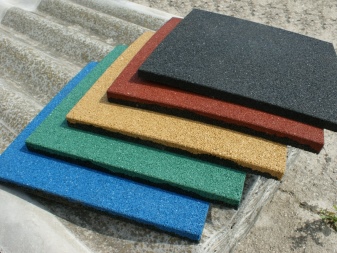
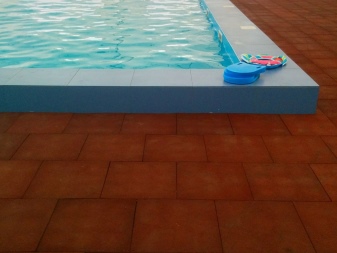
All types of tiles are available in a large assortment and have different colors - monochromatic (white, red, black and other colors), as well as with a pattern.
Top manufacturers
The market of finishing materials is represented by a large assortment of tiles; you can find products from both foreign and Russian manufacturers. The leading domestic tile manufacturer is the company Kerama marazziwhich has been on the market for over 30 years. For the manufacture of high quality products, Italian technologies are used. The produced tiles comply not only with Russian, but also international standards.
Products of the following German companies are in constant demand:
- Interbau Blinkproducing up to 40 types of ceramic tiles with non-standard colors;
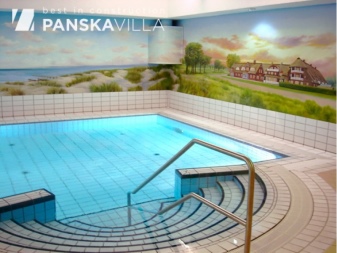
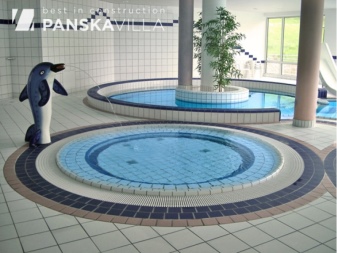
- Agrob Buchtal, which manufactures about 70 sets of luxury finishing tiles, a distinctive feature of which is a unique antibacterial coating that prevents the formation and development of bacteria.

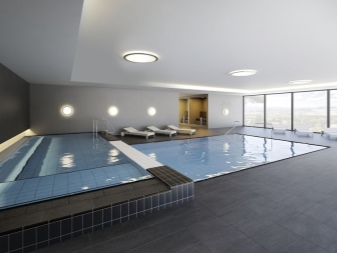
The Turkish manufacturer is represented by Serapool, which produces porcelain tiles with international quality certificates.
In addition, the products of such foreign companies are no less popular:
- Floor Gres, Trend, Skalini - Italy,
- Natural Mosaic, Primacolore - China;
- Latina Ceramica, Ceracasa - Spain.
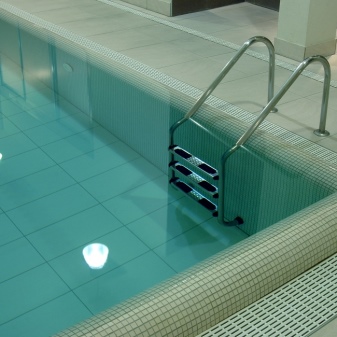
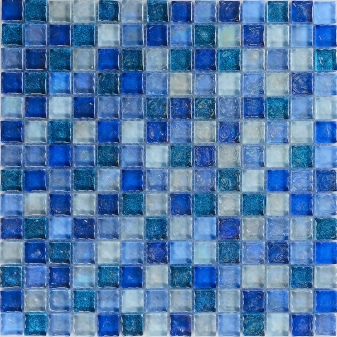
The choice of glue for styling
Not every construction adhesive mixture is suitable for facing a reservoir. Adhesive for tiles and other types of tiles must have certain qualities.
- High adhesion properties (adhesion) are necessary to securely fix the tiles and guarantee a complete seal. It is especially important that these properties do not change for the worse after final drying. The level of adhesion for tile adhesive should not be lower than 1 MPa, for mosaics this figure should not be lower than 2.5 MPa.
- Elasticity it is necessary to remove internal influences caused by constant water pressure.In addition, after drying, high-quality waterproofing should be provided with properties such as plasticity and resilience. These properties also prevent cracking.
- The glue must be waterproof, because it is constantly influenced by water.
- The presence of inert qualities. The elements included in the glue should not enter into a chemical reaction with salts and various chlorine disinfectants contained in water and cleaning agents.
- A moisture-resistant adhesive must also have good resistance to frost and high above-zero temperatures. Temperature drops should not affect and worsen its properties.
- Antifungal properties are important, preventing the formation and development of mold.
- Environmental friendliness - the required quality. The glue should not release substances harmful to human health into the water.

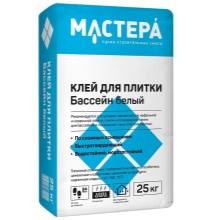
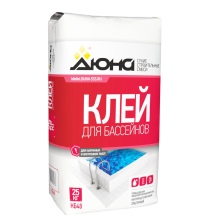
Pool tile adhesives are produced in 2 types: powder and solution. The basis of powder mixtures is cement, and solutions are prepared on the basis of acrylic, latex, polyurethane and epoxy resin.
To select a high-quality adhesive, preference should be given to 2-component latex-based adhesives: they have the highest level of adhesion. The following brands of glue are recommended:
- Unis "Pool";
- Ivsil Aqua;
- “The Pool Wins”.


Finishing technology
It is quite possible to carry out the facing of the reservoir with your own hands, if you adhere to certain rules. After completion of construction work, first remove all debris and cement laitance, clean all surfaces of the pool from contamination. After the bowl is well dried, apply with a paint roller 2 coats of primer.
After drying, the surface should be leveled by applying ready-made plasticized mixture. You can cook it yourself using sand, cement, special latex additive (Idrokol X20-m) and water.
Only after that you can proceed directly to the facing of the reservoir.
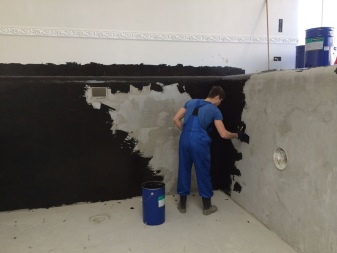
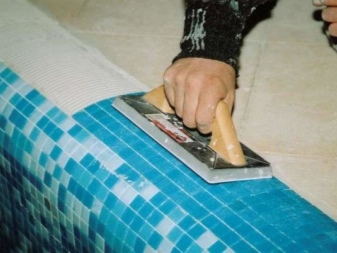
The technological process is similar to working with tiles at home.
- The cladding should be applied first to the walls of the bowl, laying out the coating in rows in a horizontal direction. It is recommended to apply markings on the surface with beacons or plumb lines: this will help to lay out the tiles directly and accurately.
- The adhesive is applied to tiles and walls with a notched trowel, the size of which must match the width of the tile. Then it is applied to the wall, leveling it with a rubber mallet.
- Lay the next item. It is important to observe a certain distance between the tiles: for this, crosses are placed in the seam, which must correspond to the selected size of the tile seam.
- They control the evenness of the laying of each element. Excess adhesive mixture around the tiles should be removed immediately: after a while it will be very difficult to do this.
- Each lined strip also needs to be checked for evenness. using the building level.

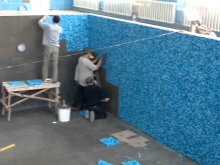
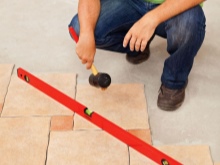
Styling panel tiles starts from the central part of the picture, gradually going down to the edges. When covering the bottom of the reservoir, a different method is used. The tiles are laid out in triangles. Previously, the bottom surface of the bowl is conventionally divided into 4 triangles, drawing diagonals.
First, the first row is laid at the pool wall, the next one is placed perpendicular to the first, and it will be the guide for the next strips. The edges of the triangles have to be laid out with cut tiles.
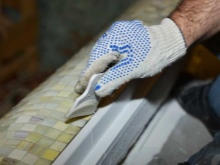
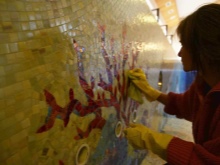
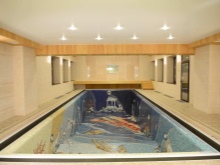
At the end of the cladding, in a day, they begin to grout the joints. It is necessary to seal inter-tile gaps and create an aesthetic and neat look. For grouting, a special composition for wet rooms is used - a fugu. It can be white or painted in the desired shade: in tone or contrasting with the tiles.
Grouting itself is a simple process. The gaps between tiles are filled with a trowel mixture.
After a while, the seams are leveled with a damp sponge and sanded.
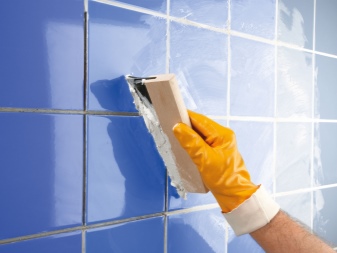
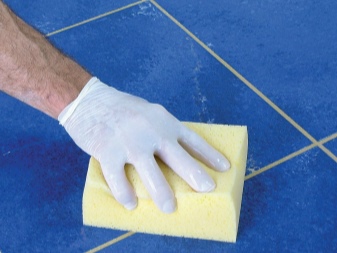
Helpful hints
The following tips from experienced craftsmen will help you get the job done right on your pool.
- For facing the pond bowl do not use large-sized tiles - they can deform under the influence of strong pressure of the water mass. Its dimensions should be no more than 12.5x24.5cm.
- Pools in the form of a rectangle can be laid out with tiles with dimensions of 15x15cm. For reservoirs with a non-standard shape, tiles with smaller dimensions will be required: with a width and length of 2-10 cm.
- For cladding outdoor pools mosaic tiles cannot be used, since they cannot withstand large temperature changes, their chips come off and you have to often repair the mosaic.
- When tiling the bowl with mosaics with small elements it is recommended to first glue them to paper sheets: this will make it easier to carry the selected elements to the desired place. To remove the paper, it should be wet.
- To cover various structural elements of the reservoir (walls, bottom, stairs) only suitable tiles should be used. Any tile has a marking that indicates the degree of water absorption, the level of anti-slip and what elements it is intended for facing.
- It is not recommended to cook a large amount of glue at once, since after 3 hours it dries up and becomes unusable.
- Dry mixes should be prepared strictly according to the instructions, without violating a single point and proportions, otherwise the glue will not have the desired quality.
- Additive to liquid glass glue increases its performance properties. This solution, which is based on sodium and potassium silicates, has a very high penetrating power. Therefore, it can be used to seal any kind of substrate.
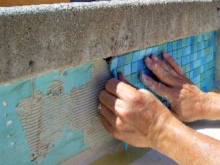


For more information on pool tiles, see the next video.



































































The comment was sent successfully.